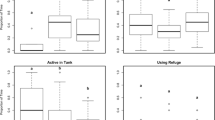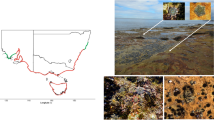Abstract
The ability to detect predators at a distance through chemical cues is often essential for prey, but spatial variation in predator presence and species may promote variability in the reactions of prey subpopulations. We collected isopods (Caecidotea communis) from three ponds: two with fish (sunfish in one, shiners in the other), and one without. We exposed individuals from these three subpopulations to kairomones and diet cues released by sunfish (Lepomis spp.) or golden shiners (Notemigonus crysoleucas). We used time-lapse photography to calculate the rate of movement and proportion of time isopods spent moving, both soon after cue introduction and twenty-five minutes later. Thus, we tested for reactions to cues, for rapid cue degradation or short-term habituation, and for effects of natal pond. The isopods from all subpopulations did not alter their rate of movement nor their percent of time moving when exposed to dechlorinated tap water or cues from sunfish. The isopods from the pond containing shiners significantly increased their proportion of time moving, and showed a not significant tendency to move more rapidly, when exposed to cues from shiners as opposed to dechlorinated tap water. Our results are the first to demonstrate that isopods may lack a behavioral response to chemicals indicating likely imminent danger from the same species of fish as occur in their natal pond.



Similar content being viewed by others
References
Abjornsson, K., Hansson L. A., & C. Bronmark, 2004. Responses of prey from habitats with different predator regimes: Local adaptation and heritability. Ecology 85: 1859–1866.
Alcock, J. 2009. Animal Behavior. 9th edn. Sinauer Associates, Inc. Sunderland, Massachusetts.
Alexander, J. E. Jr., & A. P. Covich, 1991. Predator avoidance by the freshwater snail Physella virgata in response to the crayfish Procambarus simulans. Oecologia 87: 435–442.
Augusiak, J., & P. J. Van den Brin, 2016. The influence of insecticide exposure and environmental stimuli on the movement behaviour and dispersal of a freshwater isopod. Ecotoxicology 25: 1338–1352.
Bengtsson, G. 1982. Energetic costs of amino acids exudation in the interaction between the predator Gammarus pulex L. and the prey Asellus aquaticus L. Journal of Chemical Ecology 8: 1271–1281.
Breck, J. E., & M. J. Gitter, 1983. Effect of fish size on the reactive distance of bluegill (Lepomis macrochirus) sunfish. Canadian Journal of Fisheries and Aquatic Sciences 40: 162–167.
Brown, G. E. 2003. Learning about danger: chemical alarm cues and local risk assessment in prey fishes. Fish and Fisheries 4: 227–234.
Brown, G.E., Macnaughton, C.J., Elvidge, C.K., Ramnarine. I., & J.G.J. Godin, 2009. Provenance and threat-sensitive predator avoidance patterns in wild-caught Trinidadian guppies. Behavioral Ecology and Sociobiology 63: 699–706.
Brown, G. E., Ferrari, M. C. O., Elvidge, C. K., Ramnarine, I., & D.P. Chivers, 2013. Phenotypically plastic neophobia: a response to variable predation risk. Proceedings of the Royal Society, Series B 280: 20122712.
Chivers, D. & R. Smith. 1998. Chemical alarm signalling in aquatic predator-prey systems: A review and prospectus. Ecoscience 5: 338–352.
Chivers, D. P., Brown, G. E., & R. J. F. Smith, 1996. The evolution of chemical alarm signals: Attracting predators benefits alarm signal senders. The American Naturalist 148: 649–659.
Cordelières, F. P. Manual Tracking. 2005. https://imagej.nih.gov/ij/plugins/track/ManualTrackingplugin.pdf. Accessed 29 Apr 2020
De Meester, L., Declerck, S., Stoks, R., Louette, G., Van de Meutter, F., De Bie, T., Michels, E., & L. Brendonck, 2005. Ponds and pools as model systems in conservation biology, ecology and evolutionary biology. Aquatic Conservation Marine and Freshwater Ecosystems 15: 715–725.
Feminella, J.W. & C. P. Hawkins, 1994. Tailed frog tadpoles differentially alter their feeding behavior in response to non-visual cues from four predators. Journal of the North American Benthological Society 13: 310–320.
Ferrari, M.C.O., Messier, F., Chivers, D.P., & O. Messier, 2008. Can prey exhibit threat-sensitive generalization of predator recognition? Extending the predator recognition continuum hypothesis. Proceedings of the Royal Society, Series B 275: 1811–1816.
Ferrari, M.C.O., Wisenden, B.D., & D.P. Chivers, 2010. Chemical ecology of predator–prey interactions in aquatic ecosystems: a review and prospectus. Canadian Journal of Zoology 88: 698–724.
Ferreira, T. & W. S. Rasband, 2010–2012. ImageJ User Guide—IJ 1.46. imagej.nih.gov/ij/docs/guide/.
Harris, S., Green, K. K., & L. B. Pettersson, 2013. Predator faunas past and present: quantifying the influence of waterborne cues in divergent ecotypes of the isopod Asellus aquaticus. Oecologia 173: 791–799.
Harvell, C. D. 1990. The ecology and evolution of inducible defenses. Quarterly Review of Biology 65: 323–340.
Hechtel, L. J., Johnson, C. L., & S. A. Juliano, 1993. Modification of antipredator behavior of Caecidotea intermedius by its parasite Acanthocephalus dirus. Ecology 74: 710–713.
Holomuzki, J. R., & L. A. Hatchett, 1994. Predator avoidance costs and habituation to fish chemicals by a stream isopod. Freshwater Biology 32: 585–592.
Holomuzki, J. R., & T. M. Short, 1988. Habitat use and fish avoidance behaviors by the stream-dwelling isopod Lirceus fontinalis. Oikos 52: 79–86.
Holomuzki, J. R., & T. M. Short, 1990. Ontogenetic shifts in habitat use and activity in a stream-dwelling isopod. Holarctic Ecology 13: 300–307.
Huang, C., & A. Sih, 1991. Experimental studies on direct and indirect interactions in a three trophic-level stream system. Oecologia 85: 530–536.
Jormalainen, V., Merilaita, S., & J. Tuomi, 1995. Differential predation on sexes affects color polymorphism of the isopod Idotea baltica (Pallas). Biological Journal of the Linnean Society 55: 45–68.
Jormalainen, V., Honkanen, T., Makinen, A., Hemmi, A., & O. Vesakoski, 2001. Why does herbivore sex matter? Sexual differences in utilization of Fucus vesiculosus by the isopod Idotea baltica. Oikos 93: 77–86.
Kats, L.B. & L.M. Dill, 1998. The scent of death: Chemosensory assessment of predation risk by prey animals. Ecoscience 5: 361–394.
Keogh, D. P., & T.C. Sparkes, 2003. Sexual contests in aquatic crustaceans: what’s physiology got to do with it? American Biology Teacher 65: 47–52.
Levri, E. P., Dubensky, A. N., Mears, A. S., & C. A. Opiela, 2012. Interpopulation variation in predator avoidance behavior of a freshwater snail to the same predator. Canadian Journal of Zoology 90: 616–623.
Lima, S. L. & L. M. Dill, 1990. Behavioral decisions made under the risk of predation: a review and prospectus. Canadian Journal of Zoology 68: 619–640.
McIntosh, A. R., Peckarsky, B. L., & B. W. Taylor, 1999. Rapid size-specific changes in the drift of Baetis bicaudatus (Ephemeroptera) caused by alterations in fish odour concentration. Oecologia 118: 256–264.
Merilaita, S., & V. Jormalainen, 1997. Evolution of sex differences in microhabitat choice and colour polymorphism in Idotea baltica. Animal Behaviour 54: 769–778.
NatureServe, 2019. NatureServe Explorer: an online encyclopedia of life [web application]. Version 7.1. NatureServe, Arlington, Virginia. http://explorer.natureserve.org. Accessed 11 Feb 2020.
Norton, S. F., & E. L. Brainerd, 1993. Convergence in the feeding mechanics of ecomorphologically similar species in the Centrarchidae and Cichlidae. Journal of Experimental Biology 176: 11–29.
Page, L. M., & B. M. Burr, 1991. A field guide to freshwater fishes. Houghton Mifflin Company, Boston.
Park, T., & T.C. Sparkes, 2017. Multidimensionality of modification in an isopod-acanthocephalan system. Frontiers in Ecology and Evolution. https://doi.org/10.3389/fevo.2017.00103
Pierce, C.L. 1988. Predator avoidance, microhabitat shift, and risk-sensitive foraging in larval dragonflies. Oecologia 77: 81–90.
Reebs, S. G. 2002. Plasticity of diel and circadian activity rhythms in fishes. Reviews in Fish Biology and Fisheries 12: 349–371.
Schindelin, J., Arganda-Carreras I., Frise, E., et al., 2012. Fiji: an open-source platform for biological-image analysis. Nature Methods [accessed 2020 Apr 29]. 9: 676–682.
Sehr, E. K., & B. G. Gall, 2016. Responses of an aquatic isopod and amphipod to chemical alarm cues from damaged conspecifics. Journal of Freshwater Ecology 31: 231–237.
Short, T. M. & J. R. Holomuzki, 1992. Indirect effects of fish on foraging behaviour and leaf processing by the isopod Lirceus fontinalis. Freshwater Biology 27: 91–97.
Smith, L. A., & M. M. Webster, 2015. Gammarus pulex show a grouping response to conspecific injury cues but not to predator kairomones. Behavioral Ecology 26: 1188–1195.
Spivey, K. L., Chapman, T. L., Schmitz, A. L., Bast, D. E, Smith, A.L.B., & B.G. Gall, 2015. The alarm cue obstruction hypothesis: Isopods respond to alarm cues, but do not respond to dietary chemical cues from predatory bluegill. Behaviour 152: 167–179.
Steiner, L., 2002. Pennsylvania Fishes. Pennsylvania Fish and Boat Commission. Harrisburg, PA.
Vesakoskia, O., Merilaitab, S., & V. Jormalainena, 2008. Reckless males, rational females: Dynamic trade-off between food and shelter in the marine isopod Idotea balthica. Behavioural Processes 79: 175–181.
Vollmer, K. L., B.G. Gall, 2014. Complex predator–prey interactions between the rusty crayfish (Orconectes rusticus) and invertebrate and vertebrate prey within their native range. Journal of Freshwater Ecology 29: 267–277.
Wallace, J. B., J. R. Webster, 1996. The role of macroinvertebrates in stream ecosystem function. Annual Review of Entomology 41: 115–139.
Wellborn, G. A., Skelly, D. K., & E. E. Werner, 1996. Mechanisms creating community structure across a freshwater habitat gradient. Annual Review of Ecology and Systematics 27: 337–363.
Wiggins, G. B., Mackay, R. J., & I. M. Smith, 1980. Evolutionary and ecological strategies of animals in annual temporary pools. Archiv für Hydrobiologie (Suppl.) 58: 97–206.
Williams, D. D., & K. A. Moore, 1985. The role of semiochemicals in benthic community relationships of the lotic amphipod Gamarus pseudolimnaeus: a laboratory analysis. Oikos 44: 280–286.
Wisenden, B.D. & D.P. Chivers, 2006. The role of public chemical information in antipredator behaviour. In Ladich F., S.P. Collins, P. Moller, B.G. Kapoor (eds) Communication in Fishes. Science Publisher, NH. pp. 259–278.
Wisenden, B.D., Pohlman, S.G., & E.E. Watkin. 2001. Avoidance of conspecific injury-released chemical cues by free-ranging Gammarus lacustris (Crustacea: Amphipoda). Journal of Chemical Ecology 27: 1249–1258.
Wisenden, B.D. 2015. Chemical cues that indicate risk of predation. In Sorensen, P.W. & B. D. Wisenden (eds) Fish Pheromones and Related Cues. John Wiley & Sons, Inc., New York: 131–148.
Wudkevich, K., Wisenden, B.D., Chivers, D. P., & R.J.F. Smith. 1997. Reactions of Gammarus lacustris to chemical stimuli from natural predators and injured conspecifics. Journal of Chemical Ecology 3: 1163–1173.
Zaguri, M., Zohar, Y., & D. Hawlena, 2018. Considerations used by desert isopods to assess scorpion predation risk. The American Naturalist 192: 630–643.
Zhao, X., Fox, M. G., Lasenby, D. C., Armit, A. C., & D. N. Kothawala, 2007. Substrate selection and seasonal variation in abundance and size composition of isopod Lirceus fontinalis in Ontario streams, Canada. Chinese Journal of Oceanology and Limnology 25: 215–220.
Acknowledgements
We would like to thank Graver Arboretum and Muhlenberg College (T. Shotzbarger in particular) for permission to collect animals from the ponds there, and two anonymous reviewers, D. Boix, and K. Conn for suggestions on the manuscript. We would also like to thank the John E. Trainer grant of Muhlenberg College for funding to E.C. Long, and B. Abdellatif, G. Duah, A. Goldfeder, A. Hoffman, C. Iyengar, T. Iyengar, R. Rotem and E. Schlesinger for providing assistance collecting animals. The authors declare no conflicting interests. The data that support the findings of this study are available from the corresponding author upon reasonable request.
Author information
Authors and Affiliations
Corresponding author
Ethics declarations
Conflict of interest
Elizabeth C. Long and Erika V. Iyengar declare that there are no known potential sources of conflict of interest.
Additional information
Handling editor: Dani Boix
Publisher's Note
Springer Nature remains neutral with regard to jurisdictional claims in published maps and institutional affiliations.
Rights and permissions
About this article
Cite this article
Long, E.C., Iyengar, E.V. Effects of chemical cues from two piscine predators, natal predator regime, and time since cue introduction, on the movements of aquatic isopods (Caecidotea communis). Hydrobiologia 849, 1–12 (2022). https://doi.org/10.1007/s10750-021-04698-4
Received:
Revised:
Accepted:
Published:
Issue Date:
DOI: https://doi.org/10.1007/s10750-021-04698-4




